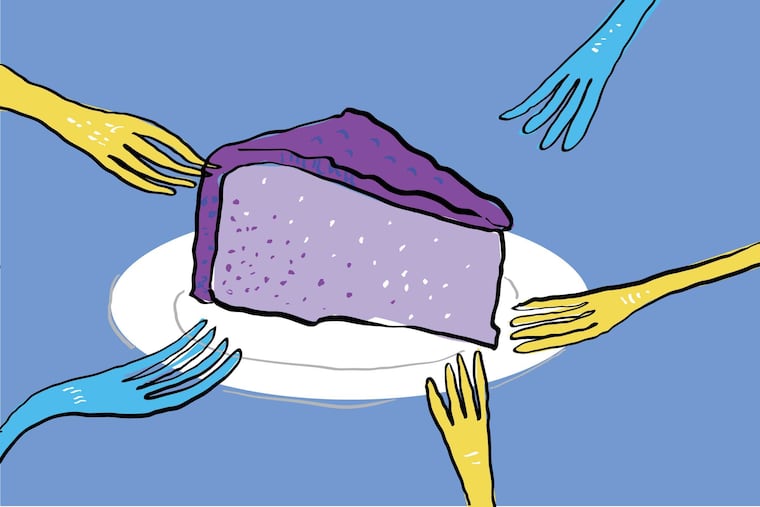We’ll still share dessert, and all the other ways we won’t change our restaurant behavior after COVID-19
Some of our pre-pandemic dining patterns may seem cringeworthy now, but in the distant future, will the memory of COVID-19 change our ways?

Imagine going out with friends before coronavirus. Maybe you dug into a bowl of free snacks over happy hour beers. Maybe you sampled one another’s cocktails to see if you liked someone else’s better before ordering a second round. Maybe you split dessert, devouring one wedge of cheesecake with four forks.
Only months ago, patrons of Midtown Village’s Graffiti Bar were gleefully sucking down scorpion bowls — fishbowls filled with something boozy, shared by straws between a few folks or more.
Some of our pre-pandemic dining patterns may seem cringe-worthy now, but in the distant future, will the memory of COVID-19 change our ways?
“I think everything goes back to the way it was if there’s a vaccine,” said Jonathan Deutsch, a professor in Drexel University’s department of food and hospitality management. “If you want evidence of that, look at states that have opened up already. ... People are out there doing it, despite the virus.”
Even as cases tick up in Philadelphia, at Headhouse Square’s Twisted Tail, customers still share the complimentary rosemary-bacon-seasoned popcorn that comes before dinner.
» READ MORE: Could COVID-19 inspire the faithful? Scholars predict spirituality surge in our future.
“A lot of people are dipping into the popcorn bag just as they normally would,” said owner George Reilly. Twisted Tail provides individual servings if diners are uncomfortable sharing, but so far customers haven’t indicated they’re skittish.
“They’re with people who they know and trust to be safe, I suppose,” Reilly said.
“We’ve all been out to dinner with friends who say, ‘Oh, I’m not going to offer to share, because I have a cold,’ ” Deutsch said. “Until now, we felt comfortable self-regulating how we deal with that risk.”
Michael Schulson owns Graffiti Bar, as well as several other restaurants that have reopened for outdoor dining. At Sampan, Double Knot, and Via Locusta, customers continue to order and share family-style meals.
“I don’t think it’s going to change, really,” Schulson said. “Everyone wants their life back.”
» READ MORE: What will sex, dating, and marriage look like on the other side of the pandemic?
Around the world, in countries where coronavirus has been better contained, life has returned to something close to normal — and so have ways of eating and drinking.
In China, many still prefer to eat from communal platters rather than use separate serving chopsticks, a change the government has tried to encourage. In Iceland, maskless diners are pushing tables together. In Taiwan, “eating out has pretty much gone back to normal” save for continued mask-wearing and sanitation efforts, says the Taipei-based food writer Katy Hui-wen Hung.
In Auckland, New Zealand, where restaurants and nightclubs are busy again — even in the absence of tourists — bar owners report that customers are sampling each other’s drinks. “It happens less frequently than before COVID,” wrote bar owner Heather Garland, “but it does still happen.”
“The people who perhaps were a little germophobic pre-COVID are now that little bit more germophobic,” wrote Ruari Hatrick, manager at Cassette Nine, a dive bar/music venue.
“It’s just a recalibration,” said Rebecca Spang, a historian at Indiana University and author of The Invention of the Restaurant.
“The thing about restaurants is that the norms that govern our behavior in them ... you don’t even know you’ve learned them,” Spang said. “And now we’re all sort of having to relearn and rethink it. And that is how institutions like restaurants change.”
» READ MORE: The impact of COVID-19 on our future vanity? Well-being will trump how we look.
But, Spang notes, restaurants — rather than customer behavior — are more likely to reconfigure themselves in the wake of COVID-19. “And customers, whether they want to or not, are going to find themselves with different kinds of options. And the question is,” she said, “whether customers will get accustomed.”
So what changes might we expect to see between the restaurants of 2019 and, say, 2023? We asked Stephani Robson, a senior lecturer at Cornell University’s School of Hotel Administration who specializes in restaurant design.
Will we see an end to cash-only establishments? Not likely, she said, as some owners will remain loath to surrender 2% to 3% of revenue to credit card fees. “It’s not so much about the restaurants going cash-only as the culture goes toward credit-only. But we’re not there yet.”
What about sitting at the bar, close to other patrons and bartenders? “Oh, that’s not going away,” Robson said, noting that not only do solo diners prefer to sit at the bar but bar seats generate more “spend per minute” than any other seats. (Communal tables, on the other hand, will likely disappear — at least for a while. “They’re around not because guests want them, but because they’re the best use of real estate a restaurant can get.”)
» READ MORE: What’s the fate of hugs, handshakes, and high-fives in a post-pandemic world?
How about brunch get-togethers? “Oh heavens, brunch is important,” Robson said. Breakfast foods (and drinks) are cheap and profitable for restaurants. Just expect gatherings to be limited in size for a time.
Well, what about scorpion bowls? “A scorpion bowl has so much alcohol in it,” Robson said, “that nothing’s going to live.”
“I don’t believe that,” said Schulson, “but they’re definitely not going away.”